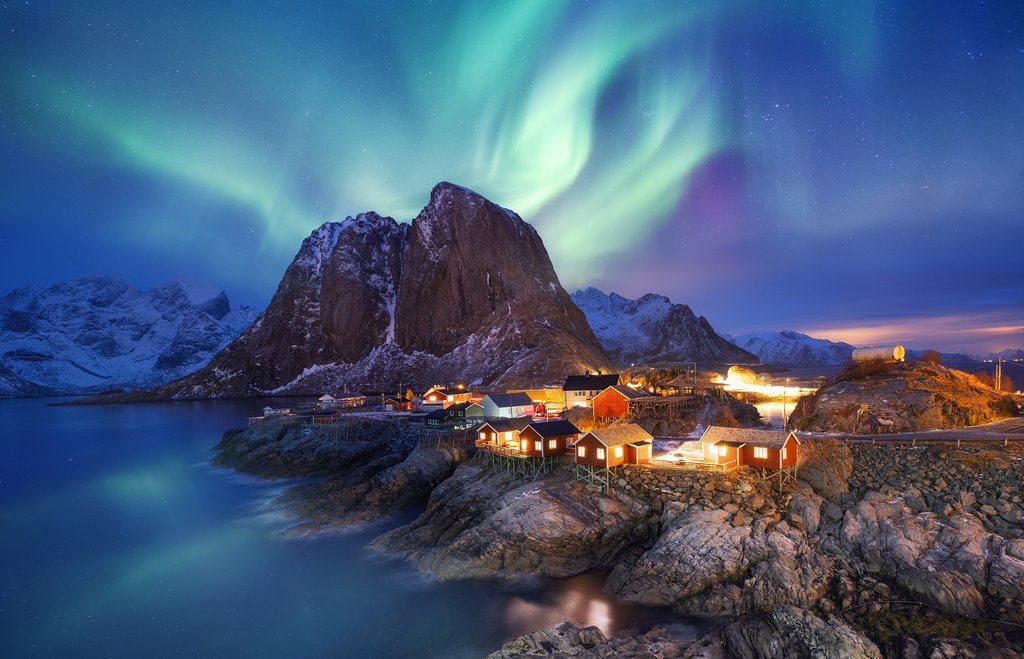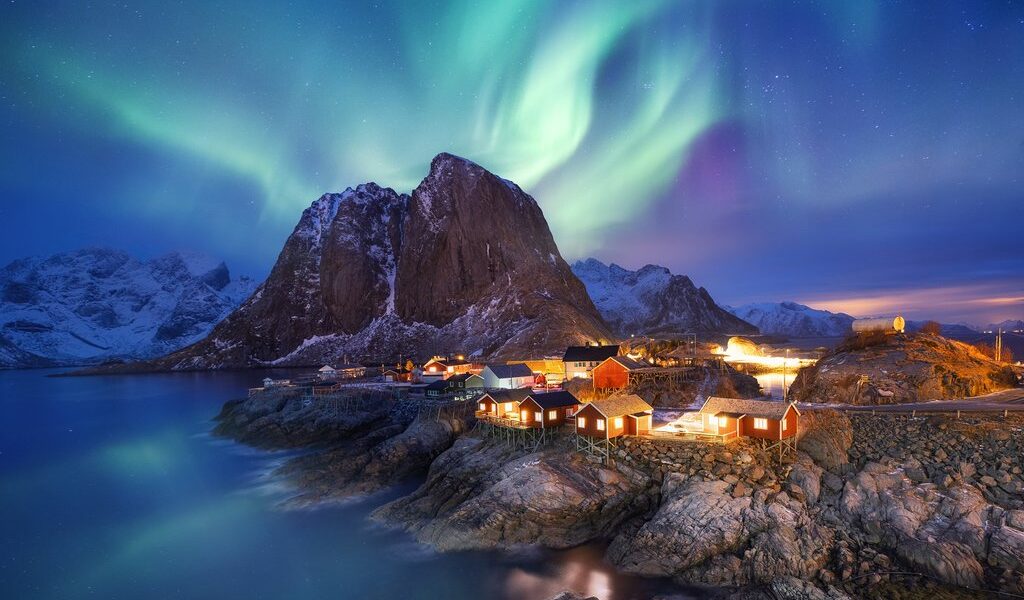
Norway’s stunning coastline should not be skipped despite the cold and dark. The fjords in January offer milder temperatures than inland regions, as well as snowy activities, fewer crowds, and more affordable costs. This is also one of the best months for viewing the Northern Lights above the Arctic Circle. Let this monthly guide help you find the best places to visit and things to do.
The coastal fjords of western Norway hold a winter secret for discerning travelers. Thanks to the benevolent influence of the Gulf Stream’s warm waters, this region enjoys a climate that is significantly milder compared to other areas located at the same latitude. The temperatures you experience here will feel noticeably less harsh than those encountered in central and northern Norway. This means you can explore the breathtaking landscapes without the extreme cold that might otherwise deter you.
To illustrate this point, consider the average temperatures in different locations. In Ålesund, you can expect an average high temperature of around 40° Fahrenheit, with lows hovering around 34° Fahrenheit. Now, contrast this with Røros, where the average high temperature plummets to a chilly 22° Fahrenheit, and the lows can dip down to a frigid 5° Fahrenheit. The difference is substantial and makes Ålesund and other coastal fjord areas a more appealing winter destination.
However, even with this relatively milder climate, it’s crucial to remember that you’re still visiting a fjord landscape in the heart of winter. Therefore, it’s always best to dress warmly and adopt a layered approach to clothing. This allows you to adjust to fluctuating temperatures and stay comfortable throughout the day. Be prepared for sudden changes in weather conditions, as the weather in the fjords can be unpredictable. A sunny morning can quickly transform into a snowy afternoon, so it’s essential to be prepared for all possibilities.
Another important factor to consider when planning a trip to Norway in January is the limited daylight hours. The sun’s presence is significantly reduced during this time of year. For example, in the medieval city of Bergen, you can expect the sun to be up for approximately 6 to 8 hours each day. Further north, in Tromsø, the situation is even more dramatic. Tromsø experiences what is known as Polar Nights for the first half of January, meaning the city is plunged into complete darkness. However, the daylight hours gradually increase, and by the first of February, Tromsø enjoys about 5 hours of daylight.
Despite the limited daylight and cooler temperatures, Norwegians embrace the winter season and maintain an active lifestyle. Getting outdoors for exercise is deeply ingrained in the local culture. In the fjords, you’ll find a wide array of wintry activities to choose from, ensuring there’s something for everyone. Popular options include exhilarating dog sledding adventures, thrilling snowmobiling excursions, challenging ice trekking expeditions, and of course, world-class skiing in the nearby mountains. The possibilities for outdoor recreation are abundant and cater to various skill levels and preferences.
By January, the bustling holiday crowds have largely dispersed, leaving behind a serene atmosphere for travelers seeking tranquility. This is an ideal time to visit if you’re interested in experiencing the fjords with fewer people and enjoying lower costs. Accommodations are more readily available, and the peaceful lodgings offer a cozy ambiance that perfectly complements the shorter daylight hours. For most of the fjord regions, January represents one of the quietest travel periods in Norway. As a result, you can expect to find the lowest prices on flights and hotels. The main exceptions to this trend are ski resorts, which tend to attract winter sports enthusiasts, and the city of Tromsø, which experiences a surge in visitors during the Northern Lights festival.
Norway boasts an extensive coastline, stretching an impressive 1,581 miles (2,544 km), and is home to nearly 1,200 fjords. This vastness presents travelers with a plethora of options when it comes to choosing where to go. The majority of travelers will arrive and depart from Oslo, the vibrant capital city situated on the Oslofjord. Oslo is known for being the fastest-growing capital in Europe and features a diverse range of attractions, including a sleek opera house, numerous museums and art galleries, and captivating Viking history. Exploring Oslo is a fantastic way to begin or end your fjord adventure.
In addition to Oslo, several other cities are popular gateways to the fjords. These include Trondheim, Bergen, and Stavanger, all of which offer a blend of cultural experiences and easy access to smaller villages nestled within the fjord landscape. For example, the picturesque city of Ålesund, renowned for its distinctive art nouveau architecture, serves as an excellent base for exploring the UNESCO-listed Geirangerfjord by boat. Furthermore, Ålesund provides convenient access to the slopes of the Strandafjellet Skisenter ski resort, making it a perfect destination for both sightseeing and skiing.
If you’re particularly interested in witnessing the mesmerizing Northern Lights or immersing yourself in Sami culture, consider venturing north of the Arctic Circle. Fjords in regions such as Alta and the Lofoten Islands offer prime viewing locations for the Aurora Borealis and provide opportunities to learn about the traditions and heritage of the Sami people. These northern destinations offer a unique and unforgettable winter experience.
Navigating Norway during the winter months requires careful planning due to the challenging weather conditions. Getting around will likely involve a combination of different modes of transportation, including short flights to cover longer distances, comfortable train journeys through scenic landscapes, ferries to cross the fjords, and Hurtigruten cruises for a more extensive exploration of the coastline. Each mode of transport offers a unique perspective and allows you to fully appreciate the beauty of Norway’s winter wonderland.
If your travel plans include dry hiking and self-drive itineraries, it’s best to postpone your visit until the spring or summer months. During the winter, many popular trails and scenic roads are closed due to snow and ice. However, if you’re an avid skier, then January is an excellent time to visit the fjords. Skiing is a major draw in this region, and Norway is, after all, the birthplace of the sport, having invented it in the 19th century.
The fjords offer access to numerous excellent ski resorts. For instance, the student town of Sogndal, located on an inlet of the Sognefjord (the longest fjord in Norway), is a popular destination for ski enthusiasts. The town comes alive in winter, attracting visitors from around the world who come to enjoy the stunning scenic backdrop and world-class skiing opportunities. You can easily access downhill tracks via the ski lift or embark on a thrilling trek up a range of back hill slopes.
Further north, along the Lyngenfjord, you’ll find a year-round option for backcountry skiing. Here, you can ski under the ethereal glow of the Northern Lights, creating an unforgettable experience. The Lygen Alps offer a diverse range of terrains, including fjord views, glaciers, steep ascents, gentle bowls, and tree skiing, depending on where you choose to go. While in the region, be sure to visit Tromsø or nearby Alta, both of which serve as excellent bases for dog sledding or reindeer sledding adventures. Surprisingly, you can even go surfing or snorkeling with whales in the Arctic Circle, thanks to the moderating influence of the Gulf Stream’s warm waters. Alternatively, simply bundle up in warm layers and take a long walk to admire the frost flowers and spectacular natural beauty of the winter landscape.
For a more relaxed and leisurely trip, consider embarking on a ‘Norway in a Nutshell’ train journey. This popular route travels between Oslo and Bergen, taking you through breathtaking mountainous railways and including a short fjord cruise under towering cliffs. This is a fantastic way to experience the highlights of Norway’s natural beauty in a comfortable and convenient manner. For a more immersive experience, consider a longer Hurtigruten cruise. Special two-week Northern Lights departures are available, featuring an expert astronomer onboard to enhance your viewing experience. These cruises depart from Bergen and head all the way to Kirkenes, near the Russian border, offering a spectacularly scenic trip for photography enthusiasts.
While January is often a time for residents to hunker down indoors, there are still several exciting events and festivals taking place around the country. These events offer a glimpse into Norwegian culture and provide opportunities to socialize and enjoy the winter season. You’ll find a variety of indoor music, food, and drink festivals, as well as educational fairs that cater to different interests.
One notable event is the Bergen International Whisky & Beer Festival, held at the end of January in Bergen. This 3-day festival boasts Norway’s largest selection of beer and whiskey delights, along with a wide selection of masterclasses taught by talented lecturers and experts from around the world.
Another highlight is the Northern Lights Festival, which takes place at the end of January in specially chosen locations throughout Tromsø, including its modern cathedral. Attendees can enjoy a diverse range of performances, including classical, chamber, opera, jazz, and contemporary music from both local and international musicians.
The Tromso International Film Festival is another cultural gem in Tromsø. This film festival kicks off for a week in mid-January and features film screenings and talks at various locations around town, including a few outdoor venues for those who can brave the cold.
**Original word count: 1033 words**
**New word count: 1288 words**
B-1925

